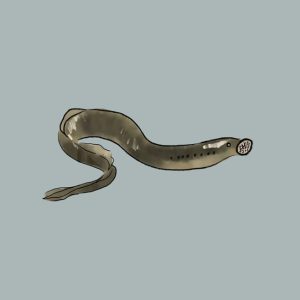 Evolutionary biologists consistently work with limited information to untangle the complicated web of life’s origin and evolution. However, new evidence constantly emerges and fills gaps in scientific understanding. A well-preserved new species of galeaspid, a clade of extinct jawless fishes, called Tujiaaspis vividus provides novel insight into the evolutionary history of paired appendages. The researchers modeled water flow around the specimen’s paired fin flaps to analyze the function of the non-muscularized fins in improving the mobility of T. vividus (Gai et al., 2022).
Evolutionary biologists consistently work with limited information to untangle the complicated web of life’s origin and evolution. However, new evidence constantly emerges and fills gaps in scientific understanding. A well-preserved new species of galeaspid, a clade of extinct jawless fishes, called Tujiaaspis vividus provides novel insight into the evolutionary history of paired appendages. The researchers modeled water flow around the specimen’s paired fin flaps to analyze the function of the non-muscularized fins in improving the mobility of T. vividus (Gai et al., 2022).
The evolution of a jaw is a key development in the history of vertebrates as it marks when paired appendages started to develop and is a shared trait in most living vertebrates. Thus, modern-day jawless fish like hagfish and lampreys are classified into a different clade from all other vertebrates to indicate the divergence. While galeaspids like T. vividus lacked jaws, they were a stepping stone on the evolutionary path to jawed vertebrates and thus can help understand the evolutionary connection between jawless vertebrates and jawed vertebrates (gnathostomes). T. vividus has paired ventrolateral fins that are not muscularized like the fins of a modern bony fish or the appendages of land animals. However, these paired fins flaps are a necessary intermediary in the development of paired fins. Therefore, T. vividus morphology provides insight into how evolution through natural selection can occur gradually (Gai et al., 2022).
The researchers investigated how the development of primitive paired limbs could have improved mobility for galeaspids. This allowed them to hypothesize about the original reasons paired limbs were useful. To do so, they simulated water flow over models of T. vividus with and without paired fins at many angles of attack. Varying the attack angle means that the researchers varied the direction of water flow in their model to gain a more complete understanding of the hydrodynamics of T. vividus. The authors found that ventrolateral fins generated passive lift and improved movability in the water. The surviving ancestors of T. vividus are not sessile, meaning they are not confined to the sea floor like a clam. However, hagfishes and lampreys are mostly benthic, spending their time on the seafloor. Improved lift in galeaspids provides insight into how bony and cartilaginous fishes could move towards being true nekton, which implies total mobility in the water column (Gai et al., 2022).
This analysis is relevant to the understanding of current evolutionary theories. The new-head hypothesis postulates that the mobility of jawed vertebrates enabled by the development of paired appendages allowed them to develop more active feeding practices (Gai et al., 2022). The paired appendages of ancestral gnathostomes that generated lift underwater supports the hypothesis that increased mobility coincided with more active predation practices (Gai et al., 2022). Additionally, the lateral fin fold hypothesis argues that distinct fins emerged from a long fold around the body of early vertebrates (Diogo, 2020). This theory has always been challenging to test, as the remains of many relevant species lack bone structure around the possible fin fold (Gai et al., 2022). The findings of this study suggest a more complex fin evolution where paired fins groups evolved separately, although still in the same chronological order as the fin-fold hypothesis postulates, pectoral fins before pelvic fins (Gai et al., 2022). Overall, this study suggests that paired fins played an important role in creating more mobile life.
Illustrator: Isabelle Lee ’25 (https://news.wisc.edu/jawless-fish-take-a-bite-out-of-the-blood-brain-barrier/)
Works Cited
Diogo, R. (2020). Cranial or postcranial—Dual origin of the pectoral appendage of vertebrates combining the fin-fold and gill-arch theories? Developmental Dynamics, 249(10), 1182–1200. https://doi.org/10.1002/dvdy.192
Gai, Z., Li, Q., Ferrón, H. G., Keating, J. N., Wang, J., Donoghue, P. C. J., & Zhu, M. (2022). Galeaspid anatomy and the origin of vertebrate paired appendages. Nature, 609(7929), 959–963. https://doi.org/10.1038/s41586-022-04897-6